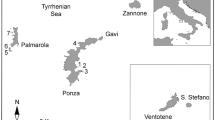Summary
The acarine fauna of two abundant species of cushion plant on the high, short-grass prairie of S.E. Wyoming were used to test The MacArthur-Wilson Theory of Island Biogeography. Multiple regression analysis using area, distance and percent moisture as independent variables and number of mite species and number of mite individuals were run for the two sampling dates. Results showed area alone to be consistently and highly correlated (r=0.84–0.94) with both species and individuals for one cushion species. The slopes of the species-area and individuals-area curves are among the highest recorded and were significantly higher on the second sampling date. Selective seasonal changes in the fauna were shown by increases both in numbers of species and individuals, mainly on larger cushions, for the later sampling period. It is hypothesized that seasonal changes are due to an increase in the number of predator species in response to an increase in the number of prey items. The slopes of the species-area curves are compared with those in the literature and it is argued that slope values are more dependent upon the taxonomic group being studied than on whether the island is insular or oceanic. Finally, we suggest that The MacArthur-Wilson Theory is not applicable to islands which 1) exhibit continuous growth, 2) lack a discrete species source, and 3) are relatively transitory.
Similar content being viewed by others
References
Barbour, C.D., Brown, J.H.: Fish species diversity in lakes. Amer. Naturalist 108, 473–489 (1974)
Brown, J.H.: Mammals on mountaintops: nonequilibrium insular biogeography. Amer. Naturalist 105, 467–478 (1971)
Butcher, J.W., Snider, R., Snider, R.: Biology of edaphic collembola and acarina. Ann. Rev. Entomol. 16, 249–288 (1971)
Cairns, J., Jr., Dahlberg, M., Dickson, K.L., Smith, N., Waller, N.T.: The relationship of fresh-water protozoan communities to the MacArthur-Wilson equilibrium model. Amer. Naturalist 103, 439–454 (1969)
Culver, D., Holsinger, J.R., Baroody, R.: Toward a predictive cave biogeography: the Greenbrier Valley as a case study. Evolution 27, 689–695 (1973)
Culver, D.C.: Analysis of simple cave communities. I. Caves as islands. Evolution 24, 463–474 (1970)
Darlington, P.J., Jr.: Carabidae of mountains and islands: data on the evolution of isolated faunas, and on atrophy of wings. Ecol. Monogr. 13, 37–61 (1943)
Dixon, W.J.: BMD biomedical computer programs. Berkeley, Calif: Univ. Calif. Press 1974
Draper, N.R., Smith, H.: Applied regression analysis. New York: Wiley 1966
Haas, P.H.: Some comments on use of the species-area curve. Amer. Naturalist 109, 371–373 (1975)
Hairston, N.G., Smith, F.E., Slobodkin, L.B.: Community structure, population control and competition Amer. Naturalist 94, 421–425 (1960)
Harrington, H.D.: Manual of the plants of Colorado. Chicago: Swallow Press 1964
Kempson, D., Lloyd, M., Ghelardi, R.: A new extractor for woodland litter. Pedobiologia 3, 1–21 (1963)
Krantz, G.W.: A manual of acarology. Corvallis, Ore.: OSU Book Stores 1970
Lassen, H.H.: The diversity of freshwater snails in view of the equilibrium theory of island biogeography. Oecologia (Berl.) 19, 1–8 (1975)
Levin, S.A.: Dispersion and population interactions. Amer. Naturalist 108, 207–228 (1974)
MacArthur, R.H., Wilson, E.O.: The theory of island biogeography. Princeton, N.J.: Princeton Univ. Press 1967
Maguire, B., Jr.: Phytotelmata: biota and community structure determination in plant-held waters. Ann. Rev. Ecol. Syst. 2, 439–464 (1971)
Opler, P.A.: Oaks as evolutionary islands for leaf-mining insects. Amer. Sci. 62, 67–73 (1974)
Platt, W.J.: The colonization and formation of equilibrium plant species associations on badger disturbances in a tall-grass prairie. Ecol. Monogr. 45, 285–305 (1975)
Preston, F.W.: The canonical distribution of commoness and rarity. I, II. Ecology 43, 185–215, 410–432 (1962)
Schoener, A.: Experimental zoogeography: colonization of marine mini-islands. Amer. Naturalist 108, 715–738 (1974)
Seifert, R.P.: Clumps of Heliconia inflorescences as ecological islands. Ecology 56, 1416–1422 (1975)
Sepkoski, J.J., Jr., Rex, M.A.: Distribution of fresh-water mussels: coastal rivers as biogeographic islands. Syst. Zool. 23, 165–188 (1974)
Simberloff, D.S.: Models in biogeography. In: Models in paleobiology (T.J.M. Schopf, ed.), pp. 160–191. San Francisco: Freeman, Cooper 1972
Simberloff, D.S.: Equilibrium theory of island biogeography and ecology. Ann. Rev. Ecol. Syst. 5, 161–182 (1974)
Simberloff, D.S., Wilson, E.O.: Experimental zoogeography of islands: the colonization of empty islands. Ecology 50, 278–295 (1969)
Simberloff, D.S., Wilson, E.O.: Experimental zoogeography of islands: a two-year record of colonization. Ecology 51, 934–937 (1970)
Slatkin, M.: Competition and regional coexistence. Ecology 55, 128–134 (1974)
Sneath, P.H.A., Sokal, R.: Numerical taxonomy. San Francisco: Freeman, Cooper 1973
Spomer, G.G.: Physiological ecology studies of alpine cushion plants. Physiol. Plant. 17, 717–724 (1964)
Stanton, N.L.: Soil microflora and microfauna. Part II. Microathropods, nematodes and decomposition. In: Final report, environmental assessment of the Black Thunder Mine Site, Campbell County, Wyoming (H.L. Bergman, M.D. Marcus, eds.), pp. VI-2-1 – VI-2-66. Laramie: Univ. of Wyoming 1976
Strong, D.R., Jr.: The insects of British trees: community equilibration in ecological time. Ann. Mo. Bot. Gard. 61, 692–701 (1974a)
Strong, D.R., Jr.: Rapid asymptotic species accumulation in phytophagous insect communites: the pests of cacao. Science 185, 1064–1065 (1974b)
Swed, F.S., Eisenhart, C.: Tables for testing randomness of grouping in a sequence of alternatives. Ann. Math. Statist. 14, 66–87 (1943)
Vuilleumier, F.: Insular biogeography in continental regions. I. The northern Andes of South America. Amer. Naturalist 104, 373–388 (1970)
Vuilleumier, F.: Insular biogeography in continental regions. II. Cave faunas from Tessin, southern Switzerland. Syst. Zool. 22, 64–76 (1973)
Whitehead, D.R., Jones, C.E.: Small islands and the equilibrium theory of insular biogeography. Evolution 23, 171–179 (1969)
Wilson, E.O.: The nature of the taxon cycle in the Melanesian ant fauna. Amer. Naturalist 95, 169–193 (1961)
Wilson, E.O., Simberloff, D.S.: Experimental zoogeography of islands: defaunation and monitoring techniques. Ecology 50, 267–278 (1969)
Wilson, E.O., Taylor, R.W.: An estimate of the potential evolutionary increase in species density in the Polynesian ant fauna. Evolution 21, 1–10 (1967)
Author information
Authors and Affiliations
Rights and permissions
About this article
Cite this article
Tepedino, V.J., Stanton, N.L. Cushion plants as islands. Oecologia 25, 243–256 (1976). https://doi.org/10.1007/BF00345101
Received:
Issue Date:
DOI: https://doi.org/10.1007/BF00345101




